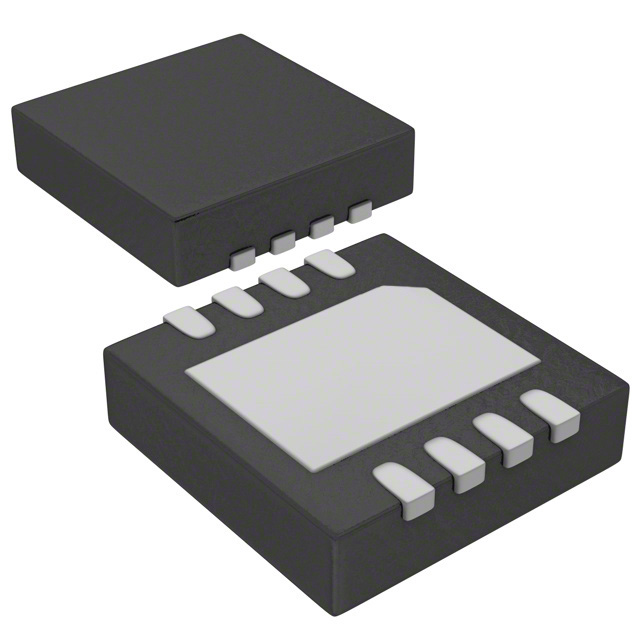Viz Specifikace pro podrobnosti o produktu.

ADP2370ACPZ-3.0-R7
Product Overview
Category
ADP2370ACPZ-3.0-R7 belongs to the category of voltage regulators.
Use
It is used to regulate and stabilize voltage in electronic circuits.
Characteristics
- Input Voltage Range: 2.5V to 5.5V
- Output Voltage: 3.0V
- Package Type: LFCSP (Lead Frame Chip Scale Package)
- Essence: Voltage regulation and stabilization
- Packaging/Quantity: Comes in a reel with 3000 units per reel
Specifications
The specifications of ADP2370ACPZ-3.0-R7 are as follows:
- Input Voltage Range: 2.5V to 5.5V
- Output Voltage: 3.0V
- Output Current: Up to 1A
- Dropout Voltage: 200mV at 1A
- Quiescent Current: 45µA
- Efficiency: Up to 95%
- Operating Temperature Range: -40°C to +125°C
- Package Type: LFCSP (8-Lead, 3mm x 3mm)
Detailed Pin Configuration
The pin configuration of ADP2370ACPZ-3.0-R7 is as follows:
- VIN: Input voltage pin
- GND: Ground pin
- EN: Enable pin
- FB: Feedback pin
- VOUT: Output voltage pin
- PGND: Power ground pin
- SW: Switching node pin
- SS/TRK: Soft-start/Tracking pin
Functional Features
- Wide input voltage range allows for flexibility in various applications.
- Low dropout voltage ensures efficient power conversion.
- High efficiency helps in reducing power dissipation.
- Enable pin provides control over the regulator's operation.
- Soft-start/Tracking pin enables smooth startup and tracking of the output voltage.
Advantages and Disadvantages
Advantages
- Wide input voltage range allows for compatibility with different power sources.
- Low dropout voltage ensures efficient power conversion even with low input voltages.
- High efficiency helps in reducing power dissipation, leading to improved energy efficiency.
- Enable pin provides flexibility in controlling the regulator's operation.
- Soft-start/Tracking feature enables smooth startup and tracking of the output voltage.
Disadvantages
- Limited output current capacity (up to 1A) may not be suitable for high-power applications.
- The LFCSP package may require careful handling during assembly.
Working Principles
ADP2370ACPZ-3.0-R7 is a voltage regulator that operates based on the principle of switching regulation. It uses an internal control loop to maintain a stable output voltage regardless of variations in the input voltage or load conditions. The regulator employs a pulse-width modulation (PWM) technique to regulate the output voltage efficiently.
When the input voltage is within the specified range, the regulator converts it into a stable 3.0V output voltage. The feedback pin continuously monitors the output voltage and adjusts the duty cycle of the internal PWM controller to maintain the desired output voltage.
Detailed Application Field Plans
ADP2370ACPZ-3.0-R7 finds applications in various electronic devices and systems, including but not limited to:
- Battery-powered portable devices: Provides regulated power supply for microcontrollers, sensors, and other components.
- IoT (Internet of Things) devices: Enables efficient power management in connected devices.
- Industrial automation: Suitable for powering control circuits and sensors in industrial equipment.
- Automotive electronics: Used in automotive modules and subsystems requiring stable voltage supply.
- Consumer electronics: Can be utilized in audio/video equipment, gaming consoles, and other consumer devices.
Detailed and Complete Alternative Models
- ADP2360ACPZ-3.3-R7: Similar voltage regulator with a 3.3V output voltage.
- ADP2380ACPZ-5.0-R7: Voltage regulator with a 5.0V output voltage and higher output current capacity.
- ADP2390ACPZ-1.8-R7: Voltage regulator with a 1.8V output voltage and lower dropout voltage.
These alternative models provide options for different output voltages and specific requirements in various applications.
Word count: 543 words
Seznam 10 běžných otázek a odpovědí souvisejících s aplikací ADP2370ACPZ-3.0-R7 v technických řešeních
Sure! Here are 10 common questions and answers related to the application of ADP2370ACPZ-3.0-R7 in technical solutions:
Q: What is the ADP2370ACPZ-3.0-R7? A: The ADP2370ACPZ-3.0-R7 is a specific model of a voltage regulator IC (integrated circuit) manufactured by Analog Devices.
Q: What is the purpose of the ADP2370ACPZ-3.0-R7? A: The ADP2370ACPZ-3.0-R7 is designed to regulate and provide a stable output voltage for various electronic devices or systems.
Q: What is the input voltage range supported by the ADP2370ACPZ-3.0-R7? A: The ADP2370ACPZ-3.0-R7 supports an input voltage range of 4.5V to 20V.
Q: What is the output voltage provided by the ADP2370ACPZ-3.0-R7? A: The ADP2370ACPZ-3.0-R7 provides a fixed output voltage of 3.0V.
Q: What is the maximum output current that can be delivered by the ADP2370ACPZ-3.0-R7? A: The ADP2370ACPZ-3.0-R7 can deliver a maximum output current of 1A.
Q: Is the ADP2370ACPZ-3.0-R7 suitable for battery-powered applications? A: Yes, the ADP2370ACPZ-3.0-R7 is suitable for battery-powered applications as it has low quiescent current and high efficiency.
Q: Does the ADP2370ACPZ-3.0-R7 have built-in protection features? A: Yes, the ADP2370ACPZ-3.0-R7 includes overcurrent protection, thermal shutdown, and undervoltage lockout features.
Q: Can the ADP2370ACPZ-3.0-R7 be used in automotive applications? A: Yes, the ADP2370ACPZ-3.0-R7 is suitable for automotive applications as it can withstand a wide operating temperature range and has automotive-grade reliability.
Q: What package does the ADP2370ACPZ-3.0-R7 come in? A: The ADP2370ACPZ-3.0-R7 comes in a small 10-lead LFCSP (lead frame chip scale package).
Q: Are there any evaluation boards or reference designs available for the ADP2370ACPZ-3.0-R7? A: Yes, Analog Devices provides evaluation boards and reference designs for the ADP2370ACPZ-3.0-R7 to help with its implementation in various applications.
Please note that the answers provided here are general and may vary depending on the specific requirements and use cases of the application. It is always recommended to refer to the datasheet and application notes provided by the manufacturer for accurate information.

